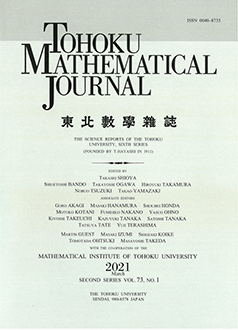Abstract
We consider Calabi–Yau 3-folds of Borcea–Voisin type, i.e. Calabi–Yau 3-folds obtained as crepant resolutions of a quotient $(S\times E)/(\alpha_S\times \alpha_E)$, where $S$ is a K3 surface, $E$ is an elliptic curve, $\alpha_S\in \operatorname{Aut}(S)$ and $\alpha_E\in \operatorname{Aut}(E)$ act on the period of $S$ and $E$ respectively with order $n=2,3,4,6$. The case $n=2$ is very classical, the case $n=3$ was recently studied by Rohde, the other cases are less known. First, we construct explicitly a crepant resolution, $X$, of $(S\times E)/(\alpha_S\times \alpha_E)$ and we compute its Hodge numbers; some pairs of Hodge numbers we found are new. Then, we discuss the presence of maximal automorphisms and of a point with maximal unipotent monodromy for the family of $X$. Finally, we describe the map $\mathcal{E}_n: X \rightarrow S/\alpha_S$ whose generic fiber is isomorphic to $E$.
Citation
Andrea Cattaneo. Alice Garbagnati. "Calabi–Yau 3-folds of Borcea–Voisin type and elliptic fibrations." Tohoku Math. J. (2) 68 (4) 515 - 558, 2016. https://doi.org/10.2748/tmj/1486177214
Information





